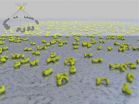(Press-News.org) An effort to develop software that unravels the complexities of how proteins fold is paying dividends in new findings on how they misfold, according to researchers at Rice University.
The study published this week in the Proceedings of the National Academy of Sciences by chemist Peter Wolynes and his team at Rice's BioScience Research Collaborative should be of particular interest to those who probe the roots of degenerative diseases associated with the aggregation of amyloid fibers in the body. These include Alzheimer's and Parkinson's diseases and Type 2 diabetes.
The molecular dynamics software to predict how strands of residues bend and twist into their functional shapes is designed to follow Wolynes' and his colleagues' groundbreaking "principle of minimal frustration." These residues, the molecular beads that make up proteins, follow the path of least resistance as they fold into their native states. The principle describes how evolution has shaped the path a protein takes toward stability.
The software, called AWSEM-MD (for associative memory, water-mediated structure and energy model) simulates the possible ways beads in a strand should fold, based on the energies at play down to the submolecular level, and accurately predicts the final structure. Two developers of the current version, Weihua Zheng, a postdoctoral researcher at Rice, and Nicholas Schafer, a graduate student, are co-authors of the new paper, the latest in a series on folding dynamics dependent on the software.
The researchers set out to confirm that a process seen by experimentalists called domain swapping is one cause of protein misfolding. Domains are conserved parts of protein chains. Occasionally, a domain in one chain may encounter its doppelgänger in a nearby chain and become entangled with it via interactions similar to those in the correctly folded state.
The result is often a dimer – a kind of protein Siamese twin – that probably won't be able to perform its intended biological task and may become part of a damaging amyloid fibril. "Experimentalists had some strong laboratory evidence that dimerization is a consequence of minimal frustration, an idea proposed earlier by our group on more general grounds," Wolynes said. "So we figured it would be nice to do a simulation to check it."
The team did indeed see domain swapping in their models of human cardiac titin, a muscle protein. But they were surprised to see something they weren't looking for: evidence that identical sequences in neighboring chains, as short as five to seven residues, had the unfortunate tendency to find each other and stick together.
They found instances of such "self-recognition" tipped the balance of energies that dictated whether a protein would fold properly. Replacing just a few residues in one fragment eliminated self-recognition and lowered the incidence of domain swapping, Wolynes said.
"We weren't the people who thought of this as a possibility," he said. "It had been suggested by others, although I never really believed it because it doesn't have an obvious connection to the principle of minimal frustration." But the simulations showed instances where sticky self-recognition in one segment of a chain could affect the energy of residues down the line and effectively introduce "frustration" that keeps the rest of the protein from folding at all and results in high disorder, or entropy.
While the models don't directly connect to the formation of amyloid fibrils, Wolynes said, anecdotal evidence indicates protein-folding diseases have some correlation with fevers that allow the extra entropy to stabilize the misfolded forms. "Our results would provide a new explanation," he said, for how a disordered part of the chain can contribute to the stability of these misfolded states at high temperature.
"When you hear 'take two aspirins and call me in the morning,' your doctor is doing you a bigger favor than you know," Wolynes said.
The discovery could open paths for researchers to design drugs that inhibit specific interactions. "Very minor changes seem to destroy this self-recognition in the computer simulation, and that's what we want the experimentalists to do: Make those changes to see if they decrease the self-recognition effect," he said.
"Our simulations provide structural details of misfolded proteins at the molecular level that are difficult for experiments to probe," Zheng said. "These can generate specific hypotheses they can test."
The researchers hope their work will be useful to both experimentalists and other computational protein-folding researchers.
"AWSEM is hosted on Google Code, which requires all code to be open-source," Schafer said. "So it's available to anyone who wants to use it. What we're seeing with these studies is that the values we get by applying the principle of minimal frustration are appropriate globally, not just for predicting the native structures of proteins. It can predict bound structures (like dimers) and misfolded structures as well.
"You always have to be careful about using models that 'rig the deck' in favor of a particular anticipated result," he said. "But what's interesting is that our model doesn't have any information a priori about these specific types of misfolded structures. Our model is parameterized using as input only experimental data for properly folded structures and then applying the principle of minimal frustration. The wide range of successes we've had this year tells me that we have a decent method for deriving the strengths of the interactions."
"We never really thought about specific kinds of misfolding or the aggregation process when we built our model around the principle of minimal frustration," Zheng said. "But they all fall into place."
###
Garegin Papoian, the Monroe Martin Associate Professor at the University of Maryland, and Aram Davtyan, a graduate student in his lab, designed and programmed most of the current version of AWSEM; this version built upon previous development by Cecilia Clementi, the Wiess Career Development Chair and a professor of chemistry and of chemical and biomolecular engineering at Rice, and others in Wolynes' labs at the University of California at San Diego and the University of Illinois at Urbana-Champaign.
The National Institute of General Medical Sciences, one of the National Institutes of Health, and the D.R. Bullard-Welch Chair at Rice University supported the research. Wolynes is the Bullard-Welch Foundation Professor of Science and a professor of chemistry and a senior scientist with the Center for Theoretical Biological Physics at Rice.
Read the paper upon publication at www.pnas.org/cgi/doi/10.1073/pnas.1222130110.
An American Chemical Society video about Wolynes' protein theory appears here:
http://www.youtube.com/watch?v=N6Al_kqmFDw.
Follow Rice News and Media Relations via Twitter @RiceUNews.
Related Materials:
AWSEM-MD downloads: http://code.google.com/p/awsemmd/.
AWSEM-MD: Protein Structure Prediction Using Coarse-Grained Physical Potentials and Bioinformatically Based Local Structure Biasing:
http://pubs.acs.org/doi/abs/10.1021/jp212541y.
Predictive energy landscapes for protein–protein association:
http://www.pnas.org/content/109/47/19244.
Funnels, Pathways, and the Energy Landscape of Protein Folding: A Synthesis: http://onlinelibrary.wiley.com/doi/10.1002/prot.340210302/abstract;jsessionid=9090D4EA3FFA5424AEEB810614E523C3.d01t04.
Wolynes Research Lab: http://wolynes.rice.edu/node/2?destination=node/2.
Center for Theoretical Biological Physics: http://ctbp.rice.edu/.
Images for download:
http://news.rice.edu/wp-content/uploads/2013/01/PROTEIN-2-WEB.jpg
A three-dimensional plot of energies in multidomain protein folding, produced at Rice University with the AWSEM-MD program, shows stable regions in blue at the bottom ("N") for the protein in its correct native state, and at the top ("I") in its incorrect, misfolded state. Both extremes are equally stable, though "N" proteins are lower in energy. Red and green represent the separate protein domains; the colors are jumbled in the domain-swapped structure (top) and in the "self-recognizing" structure (right), which have misfolded due to strong self-recognition interactions among the short residue sequences shown in the colored stripes. Researchers suspect misfolded proteins play a major role in the aggregation of amyloid fibers implicated in degenerative diseases. (Credit: Nicholas Schafer/Weihua Zheng/Rice University)
http://news.rice.edu/wp-content/uploads/2013/01/PROTEIN-1-WEB.jpg
Rice researchers, from left, Weihua Zheng, Professor Peter Wolynes and Nicholas Schafer confirmed through their computer models that "self-recognition" among short residue sequences on neighboring proteins plays a role in misfolding that may lead to aggregation. The AWSEM molecular dynamics software developed over many years by Wolynes' lab simulates the possible ways proteins may fold based on submolecular energies. (Credit: Eva Tittel/Rice University)
Located on a 300-acre forested campus in Houston, Rice University is consistently ranked among the nation's top 20 universities by U.S. News & World Report. Rice has highly respected schools of Architecture, Business, Continuing Studies, Engineering, Humanities, Music, Natural Sciences and Social Sciences and is home to the Baker Institute for Public Policy. With 3,708 undergraduates and 2,374 graduate students, Rice's undergraduate student-to-faculty ratio is 6-to-1. Its residential college system builds close-knit communities and lifelong friendships, just one reason why Rice has been ranked No. 1 for best quality of life multiple times by the Princeton Review and No. 2 for "best value" among private universities by Kiplinger's Personal Finance. To read "What they're saying about Rice," go to http://tinyurl.com/AboutRice.
Rice researchers see surprising twist to protein misfolding
AWSEM software finds new clues to degenerative diseases
2013-01-15
ELSE PRESS RELEASES FROM THIS DATE:
Diet may not impact certain health outcomes in older persons
2013-01-15
UNIVERSITY PARK, Pa. -- Eating diets high in sugar and fat may not affect the health outcomes of older adults ages 75 and up, suggesting that placing people of such advanced age on overly restrictive diets to treat their excess weight or other conditions may have little benefit, according to researchers at Penn State and Geisinger Healthcare System.
"Historically people thought of older persons as tiny and frail," said Gordon Jensen, head of the Department of Nutritional Sciences at Penn State, "but that paradigm has changed for many older persons. Currently, 30 percent ...
Will changes in climate wipe out mammals in Arctic and sub-Arctic areas?
2013-01-15
The climate changes depicted by climatologists up to the year 2080 will benefit most mammals that live in northern Europe's Arctic and sub-Arctic land areas today if they are able to reach their new climatic ranges. This is the conclusion drawn by ecologists at Umeå University in a recently published article in the journal Plos ONE.
The scientists Anouschka Hof, Roland Jansson, and Christer Nilsson of the Department of Ecology and Environmental Science at Umeå University investigated how future climate changes may come to impact mammals in northern Europe's Arctic and ...
Generic HIV treatment strategy could save nearly $1 billion annually but may be less effective
2013-01-15
NEW YORK (Jan. 14, 2013) -- Replacing the combination of brand-name, antiretroviral drugs currently recommended for control of HIV infection with soon-to-be-available generic medications could save the U.S. health care system almost $1 billion a year but may diminish the effectiveness of HIV treatment. A study led by Massachusetts General Hospital (MGH) and Weill Cornell Medical College investigators, appearing in the January 15 Annals of Internal Medicine, examines the potential impact of such a change.
"The switch from branded to generic antiretrovirals would place ...
Scientists discover structure of protein essential for quality control, nerve function
2013-01-15
LA JOLLA, CA – January 14, 2013 – Using an innovative approach, scientists at The Scripps Research Institute (TSRI) have determined the structure of Ltn1, a recently discovered "quality-control" protein that is found in the cells of all plants, fungi and animals.
Ltn1 appears to be essential for keeping cells' protein-making machinery working smoothly. It may also be relevant to human neurodegenerative diseases, for an Ltn1 mutation in mice leads to a motor-neuron disease resembling amyotrophic lateral sclerosis (ALS, also known as Lou Gehrig's disease).
"To better ...
CU-led study shows pine beetle outbreak buffers watersheds from nitrate pollution
2013-01-15
A research team involving several scientists from the University of Colorado Boulder has found an unexpected silver lining in the devastating pine beetle outbreaks ravaging the West: Such events do not harm water quality in adjacent streams as scientists had previously believed.
According to CU-Boulder team member Professor William Lewis, the new study shows that smaller trees and other vegetation that survive pine beetle invasions along waterways increase their uptake of nitrate, a common disturbance-related pollutant. While logging or damaging storms can drive stream ...
Supplements and cow's milk play biggest roles in determining vitamin D levels in children
2013-01-15
TORONTO, Jan 14, 2013—Taking a vitamin D supplement and drinking cow's milk are the two most important factors that determine how much vitamin D is in a child's body, new research has found.
Those factors play a bigger role than even skin colour and exposure to the sun, according to Dr. Jonathon Maguire, a researcher and pediatrician at St. Michael's Hospital.
"Early childhood is a critical stage in human development, so achieving and maintaining optimal vitamin D levels in early childhood may be important to health outcomes in later childhood and adulthood," Dr. Maguire ...
NASA sees strength in newborn Tropical Cyclone Emang
2013-01-15
Tropical Cyclone Emang developed in the Southern Indian Ocean on Sunday, Jan. 13 about 525 nautical miles east-southeast of Diego Garcia. At that time, infrared satellite imagery revealed that the low level circulation center was partially exposed to outer winds, and there was a burst of thunderstorm development over the northwestern quadrant.
NASA's Tropical Rainfall Measuring Mission (TRMM) satellite captured rainfall rates in Tropical Storm Narelle on Jan. 13 at 0907 UTC (5:07 a.m. EST). Moderate and heavy rainfall was occurring around the center of circulation, where ...
New sunspots producing space weather
2013-01-15
On Jan. 13, 2013, at 2:24 a.m. EST, the sun erupted with an Earth-directed coronal mass ejection or CME. Not to be confused with a solar flare, a CME is a solar phenomenon that can send solar particles into space and reach Earth one to three days later.
Experimental NASA research models, based on observations from the Solar Terrestrial Relations Observatory (STEREO) and the ESA/NASA mission the Solar and Heliospheric Observatory, show that the CME left the sun at speeds of 275 miles per second. This is a fairly typical speed for CMEs, though much slower than the fastest ...
Patient expectations of acute bronchitis not consistent with the best evidence
2013-01-15
Athens, Ga. – New research from the University of Georgia exposes a large discrepancy in the length of time patients expect an acute cough illness, also called acute bronchitis, to last and the reality of the illness. This mismatch may be a factor in the over-prescription of antibiotics.
Examining the gap in patient expectations and the actual length of time the body takes to rid itself of a chest cold, Dr. Mark Ebell, associate professor of epidemiology in the UGA College of Public Health, recently published an article in the Annals of Family Medicine. His results show ...
Tamoxifen ameliorates symptoms of Duchenne muscular dystrophy
2013-01-15
Philadelphia, PA, January 15, 2013 – A new study has found that tamoxifen, a well-known breast cancer drug, can counteract some pathologic features in a mouse model of Duchenne muscular dystrophy (DMD). At present, no treatment is known to produce long-term improvement of the symptoms in boys with DMD, a debilitating muscular disorder that is characterized by progressive muscle wasting, respiratory and cardiac impairments, paralysis, and premature death. This study will be published in the February 2013 issue of The American Journal of Pathology.
Using the mdx5Cv mouse ...
LAST 30 PRESS RELEASES:
New expert guidance urges caution before surgery for patients with treatment-resistant constipation
Solar hydrogen can now be produced efficiently without the scarce metal platinum
Sleeping in on weekends may help boost teens’ mental health
Study: Teens use cellphones for an hour a day at school
After more than two years of war, Palestinian children are hungry, denied education and “like the living dead”
The untold story of life with Prader-Willi syndrome - according to the siblings who live it
How the parasite that ‘gave up sex’ found more hosts – and why its victory won’t last
When is it time to jump? The boiling frog problem of AI use in physics education
Twitter data reveals partisan divide in understanding why pollen season's getting worse
AI is quick but risky for updating old software
Revolutionizing biosecurity: new multi-omics framework to transform invasive species management
From ancient herb to modern medicine: new review unveils the multi-targeted healing potential of Borago officinalis
Building a global scientific community: Biological Diversity Journal announces dual recruitment of Editorial Board and Youth Editorial Board members
Microbes that break down antibiotics help protect ecosystems under drug pollution
Smart biochar that remembers pollutants offers a new way to clean water and recycle biomass
Rice genes matter more than domestication in shaping plant microbiomes
Ticking time bomb: Some farmers report as many as 70 tick encounters over a 6-month period
Turning garden and crop waste into plastics
Scientists discover ‘platypus galaxies’ in the early universe
Seeing thyroid cancer in a new light: when AI meets label-free imaging in the operating room
Neutrophil-to-lymphocyte ratio may aid risk stratification in depressive disorder
2026 Seismological Society of America Annual Meeting
AI-powered ECG analysis offers promising path for early detection of chronic obstructive pulmonary disease, says Mount Sinai researchers
GIMM uncovers flaws in lab-grown heart cells and paves the way for improved treatments
Cracking the evolutionary code of sleep
Medications could help the aging brain cope with surgery, memory impairment
Back pain linked to worse sleep years later in men over 65, according to study
CDC urges ‘shared decision-making’ on some childhood vaccines; many unclear about what that means
New research finds that an ‘equal treatment’ approach to economic opportunity advertising can backfire
Researchers create shape-shifting, self-navigating microparticles
[Press-News.org] Rice researchers see surprising twist to protein misfoldingAWSEM software finds new clues to degenerative diseases




